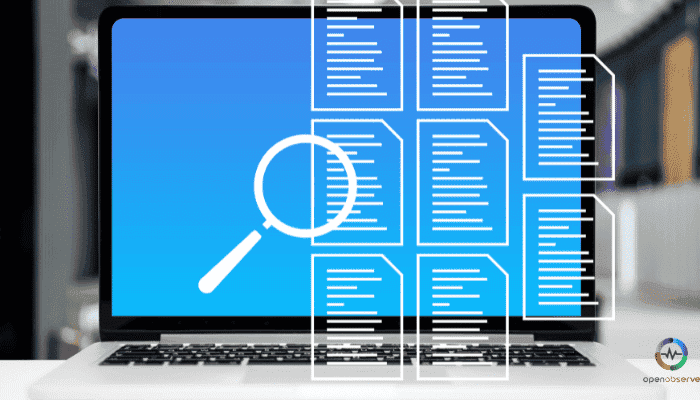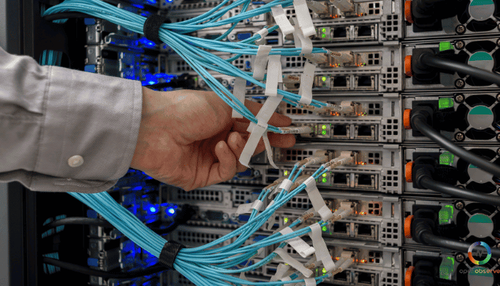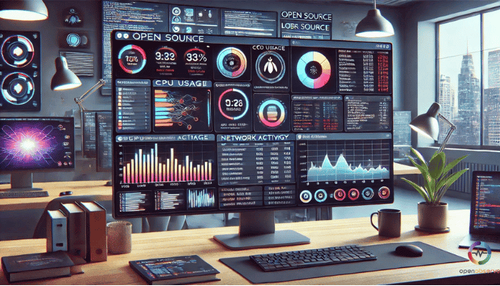
Building Open Source Observability Platform: Tools and Testing
Introduction to Building an Open Source Observability Platform
What's the Buzz about Open Source Observability?

Think of it as your superpower to understand what's happening within your complex distributed systems. It's like having X-ray vision into the inner workings of your applications and infrastructure.
Picture yourself running a fleet of microservices in the cloud, and suddenly something goes wrong. Without proper observability, it's like stumbling around in the dark with a blindfold on.
You need insights, metrics, and logs to troubleshoot issues, optimize performance, and ensure everything runs smoothly.
Challenges Galore: Monitoring in a Distributed World
As your architecture becomes more distributed and dynamic, traditional monitoring tools start to sweat bullets. They struggle to keep up with the sheer volume, variety, and velocity of data flying around.
Imagine trying to track down a performance bottleneck when your services are scattered across multiple clusters and regions. Nightmare, right?
Plus, there's the added complexity of dealing with ephemeral containers, serverless functions, and ever-evolving infrastructure.
Embracing the Open Source Revolution
Now, here's where the plot thickens.
Enter open source observability tools to save the day!
With open source, you're not locked into a single vendor or beholden to exorbitant licensing fees. You have the power to customize, extend, and contribute back to the community.
But wait, why the sudden shift towards open source?
It's all about collaboration and innovation. The collective brainpower of developers around the globe is a force to be reckoned with. By pooling our resources and sharing our knowledge, we can build better tools, faster.
Understanding the Core of Open Source Observability

As you get into building your open source observability platform, it's crucial to get a firm grip on its fundamental elements.
This isn't just about piling on various tools and hoping they mesh well. Instead, you need to understand the specific roles and interactions of metrics, logs, and traces—each acting as critical spokes in the wheel of observability.
Metrics, Logs, and Traces: The Big Three
Consider metrics, logs, and traces as the triumvirate of open source observability. Each serves a distinct purpose:
- Metrics: These are numerical data that measure the operation of your system over time. Think of them as the heartbeat monitor of your application, providing real-time insights into its health.
- Logs: If metrics tell you something is wrong, logs tell you what exactly happened. They are the detailed records of events that occur within your system.
- Traces: Traces show you the journey of a request across various services. They are crucial for understanding the path and pinpointing issues in complex distributed systems.
By integrating these three, you gain a comprehensive view of your system's inner workings, which is essential for quick diagnostics and effective problem-solving.
Solving the Data Analytics Puzzle in Observability
The crux of observability lies not just in collecting data but in making sense of it.
The challenge here is vast and varied data. Without a structured approach to data analytics, this deluge can be as clear as mud.
You need tools that not only collect diverse data but also help you analyze and interpret it effectively, ensuring you can react swiftly to any anomalies.
Embracing Shift-Left in DevOps
Now, let's talk about integrating observability early into your development process, a strategy known as 'shift-left'.
This approach is about embedding testing and observability into the earliest stages of your software development life cycle.
Why wait for a fire to start if you can prevent it in the first place?
By shifting observability left, you ensure that every piece of code is born under the watchful eyes of robust monitoring tools, paving the way for fewer surprises down the line and a smoother deployment phase.
This proactive stance significantly reduces the 'oops' moments that can otherwise occur post-deployment.
Key Open Source Tools for Observability

In the world of software development, especially when managing complex systems, the importance of observability cannot be overstated. It's your window into the operational health of your applications.
Let's look into some of the key open source tools that can empower your observability strategies.
- OpenObserve: The Game-Changer in Observability
- Rapid Deployment: Get OpenObserve up and running in under 2 minutes—simplicity at its best.
- Cost Efficiency: Dramatically reduce your log storage costs by approximately 140x compared to traditional solutions like Elasticsearch.
- Versatile Storage Options: Whether on a local disk in single node mode or across distributed systems using S3-compatible storage, OpenObserve is flexible.
- Comprehensive Capabilities: From logs to metrics and traces, handle everything through a single, unified platform.
- Built-In Functions: Enrich, redact, or transform data during ingestion or querying—all from a user-friendly interface.
- Scalability: Efficiently scalable from a small Raspberry Pi setup to a 300-node cluster handling petabytes of data daily.
For more details on why OpenObserve could be your next observability platform, check out their blog and explore their GitHub page to join the community. Or sign up now and get started!
- Prometheus: Your Metrics Workhorse
- Comprehensive Monitoring: Continuously collects and stores metrics in real-time.
- Flexible Queries: Utilize Prometheus’s powerful query language for detailed data retrieval and visualization.
- Active Community: Leverage the extensive Prometheus community for collaborative development and support.
- Alert Management: Features built-in alert rules for real-time monitoring.
- High Scalability: Handles large volumes of data with ease, making it suitable for complex networks.
- Loki: Log Aggregation Made Simple
- Efficient Storage: Optimized for storing and querying logs at scale.
- Tight Integration: Seamlessly integrates with Grafana for effortless visualization.
- Scalable Architecture: Designed to scale horizontally, simplifying operational management.
- Multi-Tenant Support: Supports multi-tenancy which is ideal for managed service providers.
- Cost-Effective: Minimizes costs related to logging through efficient indexing and compression.
- OpenTelemetry: Unified Observability Framework
- Unified Observability: Combines metrics, logs, and traces into a cohesive framework.
- Cross-Language Support: Supports numerous programming languages, ensuring wide applicability.
- Extensibility: Easily extendable with custom instrumentation and exporters.
- Vendor-Neutral: Avoids vendor lock-in, providing flexibility in tool choices.
- Rich Ecosystem: Supported by a robust ecosystem of tools and community contributions.
- Jaeger and Zipkin: Mastering Distributed Tracing
- Detailed Insights: Provides granular insights into distributed system behaviors.
- End-to-End Tracing: Enables comprehensive tracking of requests across microservices.
- Root Cause Analysis: Facilitates quick diagnosis of failures within distributed systems.
- Community Driven: Both tools are supported by strong communities that drive continuous innovation.
- Flexibility and Compatibility: Offers flexibility in deployment options and compatibility with other observability tools.
- Grafana: Visualize What Matters
- Rich Visualizations: Create compelling, dynamic visualizations with Grafana’s powerful dashboarding capabilities.
- Multi-DataSource Support: Aggregate data from multiple sources into unified dashboards.
- Alerting & Notifications: Keep on top of operational issues with real-time alerting.
- Customizable: Highly customizable for different use cases and preferences.
- Community and Plugins: Supported by a large community and a wide range of plugins for enhanced functionality.
As you build or enhance your observability stack, consider how these tools can integrate into your workflow.
Each tool, especially OpenObserve with its standout features, offers unique capabilities that can be strategically utilized for comprehensive system monitoring and analysis. Whether you're dealing with logs, metrics, or traces, OpenObserve provides a seamless and efficient approach to navigate the complexities of modern systems observability.
Optimizing Your Telemetry: OpenObserve and Unified Collection

When managing complex, distributed systems, having a clear, comprehensive observability strategy is paramount. OpenObserve, alongside OpenTelemetry, can significantly enhance this strategy by providing a more integrated and efficient approach to handling telemetry data.
The Challenge of Telemetry Data Collection
Collecting telemetry data can be like trying to listen to multiple conversations at a busy party — you know the information is valuable, but it's hard to focus and filter out what's important.
OpenObserve, known for its efficiency and simplicity, can help you manage this data more effectively. Its ability to handle logs, metrics, and traces under one roof means you can turn down the noise and tune into the insights that matter most.
Integrating OpenObserve with OpenTelemetry
OpenTelemetry provides a unified framework to collect and transfer telemetry data across various parts of your application, making it an ideal partner for OpenObserve. Here’s how you can integrate them:
- Instrumentation: Begin by setting up OpenTelemetry to collect basic telemetry data across your systems. This data then feeds into OpenObserve, which aggregates and analyzes it.
- Simplification: With OpenObserve's intuitive interface, you can easily visualize the data collected by OpenTelemetry. This integration simplifies not just data collection but also its analysis and storage, reducing overhead.
- Efficiency: OpenObserve's promise of reducing storage costs by up to 140x makes it an economically wise choice for handling large volumes of data processed by OpenTelemetry.
The Benefits of a Unified Approach with OpenObserve
Using OpenObserve in tandem with OpenTelemetry for your telemetry needs offers several advantages:
- Cost-Effective Scaling: As your data grows, OpenObserve ensures that your costs don’t spiral out of control, thanks to its efficient data compression and storage mechanisms.
- Enhanced Insights: The combination of OpenTelemetry’s comprehensive data collection with OpenObserve’s analytical prowess allows you to gain deeper insights into the health and performance of your applications.
- Streamlined Operations: With both tools working together, you streamline operations by reducing the complexity of your observability stack. This unified approach not only saves time but also makes it easier for your teams to collaborate and share insights.
By integrating OpenObserve with OpenTelemetry, you create a robust framework for telemetry that not only simplifies data collection and analysis but also enhances the overall observability of your systems.
This cohesive approach allows you to maintain high performance and reliability with greater ease and less expense. Embrace this unified strategy to make your observability efforts as effective and efficient as possible.
Sign up to OpenObserve or visit the github and get started!
Testing within an Observability Framework

Why Testing Matters
Testing is like the guardian angel of your system, ensuring its performance and integrity stay top-notch. Think of it as your safety net, catching any bugs or issues before they wreak havoc on your platform.
Types of Tests
When it comes to testing within an observability framework, you've got a few key players:
- Integration Tests: These bad boys ensure that all the different parts of your system play nicely together. They're like the glue that holds everything in place.
- Functional Tests: These tests focus on specific functions or features of your platform, making sure they work as intended. It's all about keeping things functional and user-friendly.
- End-to-End Tests: The big kahuna of testing, these tests simulate real-world scenarios from start to finish. They give you the full picture of how your platform performs in the wild.
Embracing Open-Source Testing Tools
Now, let's talk tools.
When it comes to testing within your observability framework, open-source is the name of the game. Here are a couple of gems you'll definitely want in your toolbox:
- Tracetest: This tool is like your trusty sidekick, helping you track and trace every little detail of your system's performance. With Tracetest by your side, nothing goes unnoticed.
- Malabi: Another must-have tool, Malabi is all about ensuring your observability platform stays in tip-top shape. It's like your personal health monitor, keeping tabs on everything from metrics to traces.
Challenges and Considerations in Building an Observability Platform

Tool Sprawl and the Integration Challenge
Let's face it: the tech world is a jungle, and navigating through all the different tools can feel like an expedition into the unknown. The key here is finding tools that play well together, minimizing the headache of integration.
Relicensing Issues with Open Source Tools
Ah, the tangled web of open source licenses. It's a maze out there, but with a bit of careful planning and consideration, you can navigate through it without getting lost.
Considerations for Regulatory Compliance and Security
Regulatory compliance and security are like the bodyguards of your platform, ensuring it stays safe and compliant in a world full of threats. It's crucial to stay on top of regulations and best practices to keep your platform out of harm's way.
Importance of a Unified UI for Observability
Imagine trying to navigate through a tangled mess of interfaces—talk about a headache! A unified UI for your observability platform is like having a trusty map that guides you through the wilderness, making it easy to find what you need when you need it.
Future Directions in Open Source Observability

Integration and Consolidation of Tools for Better Usability
The future is all about simplifying the complex. By integrating and consolidating tools, we can streamline the user experience, making observability more accessible to everyone.
Incorporation of AI and Machine Learning for Advanced Data Analytics
Get ready for some serious brainpower! AI and machine learning are the secret sauce for unlocking advanced insights from your data, taking observability to new heights of sophistication.
Improving User Experience and Support for Regulatory Compliance
User experience is king in the world of observability. By focusing on simplicity and ease of use, we can make observability more intuitive and user-friendly while still keeping compliance front and center.
Conclusion
So, what's the big takeaway from all of this?
As technology continues to evolve at breakneck speed, the need for robust observability solutions becomes more critical than ever. With the rise of complex distributed systems and cloud-native architectures, being able to understand and troubleshoot issues in real-time is no longer a luxury—it's a necessity.
So, what's the secret sauce for success in the world of observability? It's all about taking a holistic approach.
From choosing the right tools to implementing rigorous testing strategies, every decision you make should be guided by a commitment to excellence and a dedication to delivering the best possible experience for your users.



